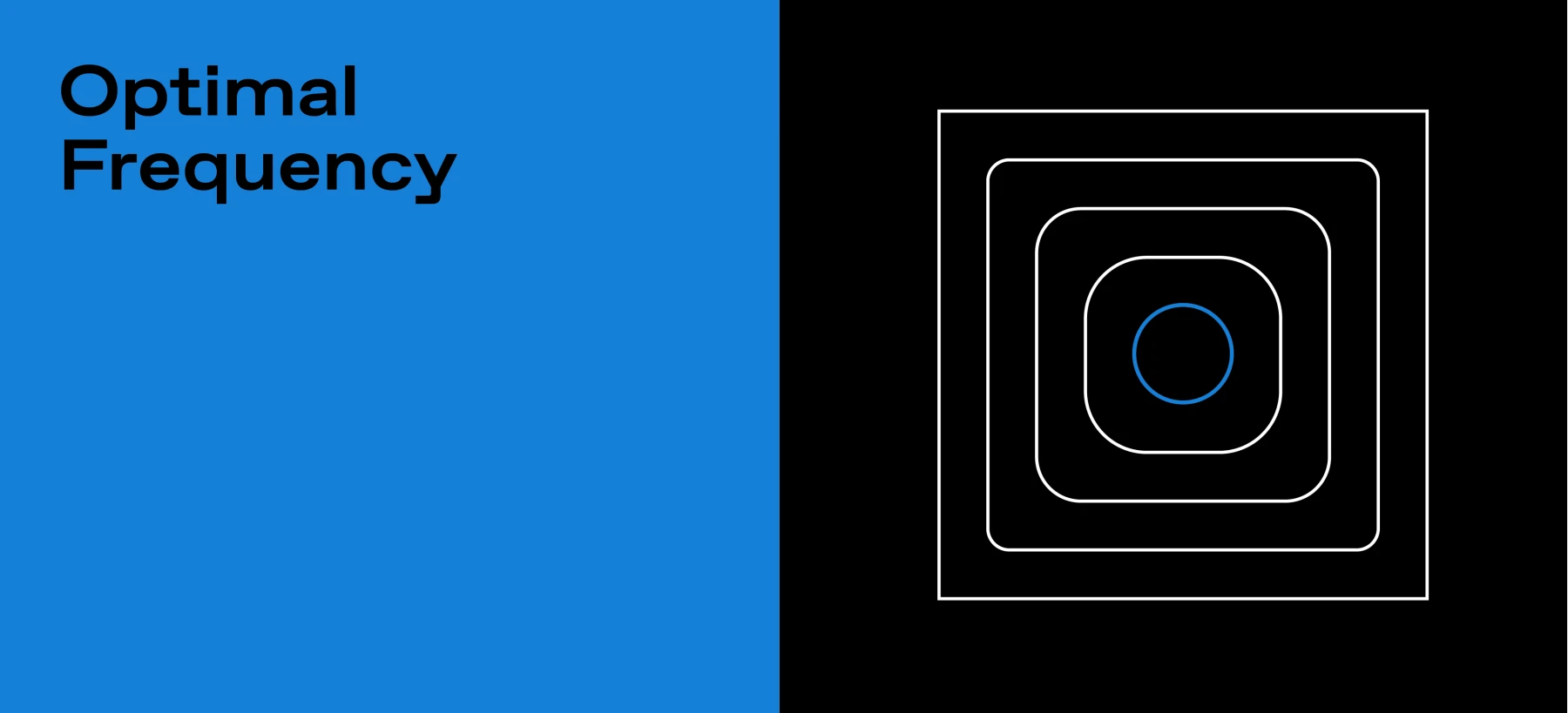
Finding the Sweet Spot: Optimizing Ad Frequency for Maximum Impact
In the world of TV advertising, getting the right message in front of the right audience is only half the battle. The other half? Ensuring that your audience sees your message the optimal number of times to drive action without wasting ad spend. This is where understanding and optimizing ad frequency becomes a game-changer for performance marketers.
Why Optimal Frequency Matters
At Tatari, we know that the frequency of ad exposures plays a crucial role in determining the success of a media plan. Simply put, optimal frequency is about hitting that sweet spot where your ads are seen enough times to make an impact but not so often that they lead to diminishing returns (or even annoying the viewer).
Our platform harnesses a wealth of data to calculate key delivery metrics such as reach and frequency. Unlike other platforms that may only provide average metrics, Tatari offers the full distribution of these metrics, allowing for a more nuanced and accurate analysis. By displaying the complete distribution—illustrated through our R/F histogram—you gain insights into the precise impact of your ad campaigns across different frequency levels. This comprehensive view is key to identifying the optimal frequency that drives the best performance for your campaigns.
More importantly, our closed-loop attribution techniques allow us to tie household-level frequency directly to performance outcomes, providing a clear picture of how ad exposure translates into actions—like website visits or app installs—at every stage of the customer acquisition funnel.
Decoding Frequency Response
When we talk about 'Frequency Response' at Tatari, we’re referring to the detailed analysis that connects the frequency of ad impressions to measurable client performance. Imagine each ad impression as a mini experiment, where the outcome is either a positive action, such as a website visit, or no action at all.
We break down these positive responses even further into two main categories: upper-funnel actions, like website visits or app installs, and lower-funnel actions, such as purchases or subscriptions. By analyzing how these responses vary with different frequencies, we can determine not just how often ads should be shown, but how those ads should be spaced out over time to maximize their effectiveness.
The Science Behind Total Efficiency
To quantify the effectiveness of different frequencies, we use two key metrics: the response rate (the likelihood of a viewer responding to an ad) and the conversion rate (the likelihood of a responder making a purchase or other monetizing decision). The product of these two rates gives us the total efficiency—a critical measure that tells us the probability that an ad view will lead to a full journey from awareness to conversion.
Total Efficiency = Response Rate * Conversion Rate
Our methodology involves looking back over a fixed time window, typically one week, to determine the frequency of ad impressions. This window can be adjusted based on specific campaign needs, but the goal remains the same: to identify the frequency that delivers the highest total efficiency.
Above: Example of an ad impressions on a timeline with other impressions in the household. The present (rightmost) impression has 2 other impressions within its lookback period, so it would fall in the N = 3 frequency bucket.
Above: Example of an adview with an associated session start initiated by a pageview. The impressions marked in red would count within the window, so this impression resulting in a pageview and a conversion would be added to the freq=4 bucket. Note that additional impressions occurring during the session do not increase the frequency under our framework.
Incrementality and Its Importance
One of the unique aspects of Tatari's approach is our focus on incrementality. We isolate the impact of each additional ad impression to understand its incremental contribution to the overall performance. This allows us to determine the true value of each subsequent impression, ensuring that we’re not just inflating frequency for the sake of it, but rather strategically optimizing it.
For instance, the impact of a fourth impression is analyzed independently of the first, second, and third impressions. This detailed approach helps avoid the common pitfall of oversaturation, where too many impressions can lead to audience fatigue and reduced ad effectiveness.
Defining and Achieving Optimal Frequency
So, how does Tatari determine the optimal frequency? We start by identifying the frequency level that maximizes total efficiency for a client. From there, we expand our focus to include adjacent frequency levels that still maintain at least 60% of that maximum efficiency. This creates what we call the optimal frequency range—a tailored strategy that balances effectiveness with cost efficiency.
This 60% threshold is based on extensive testing and real-world application, though it can be adjusted to align with specific campaign goals. The result is a dynamic, data-driven approach that adapts to the unique needs of each client, ensuring that every ad dollar is spent wisely.
Above: Example of a typical frequency response profile showing incremental response and conversion rates. In this case, all values are indexed to their respective values for the N=1 frequency buckets.
In the above example, the efficiency peaks at in the N=3 frequency bucket. Based on the 60% criteria described above, we would include frequencies of 1 through 8 in the optimal frequency range. Above a frequency of 8, the total efficiency has decreased sufficiently that it is no longer economical to add impressions within this frequency range.
How Tatari's Approach Stacks Up
When it comes to calculating optimal frequency, different methods can lead to significantly different strategies. For example, The Trade Desk uses a cumulative conversion approach, where optimal frequency is determined by comparing cumulative fractional conversions against the amount of spend. The idea is to find the frequency point where the difference between conversions and spend is maximized, often leading to a frequency recommendation where this difference reaches its peak.
Above: Incremental and cumulative efficiency distributions for the synthetic frequency result curve presented in the last section. The dashed red line shows the cumulative conversions spend difference for the same frequency response curve, assuming a typical power-law distribution of household frequency numbers (HH(N) = (50-N)^3).
While this approach might seem intuitive, it has its drawbacks. One major issue is that it can introduce bias into the frequency calculation by conflating delivery statistics with frequency response. This method tends to favor higher frequency levels because it does not account for the diminishing returns that occur when an audience is oversaturated with ads. As a result, it might lead to recommendations that encourage oversaturation, ultimately reducing the efficiency of your ad spend.
Tatari's approach, on the other hand, focuses on the independent efficiency of each frequency level. Instead of looking at cumulative data, we assess the incremental impact of each additional ad impression. This allows us to isolate the true effect of each frequency level on performance, free from the biases introduced by historical buying strategies. By focusing on how each frequency contributes to overall efficiency, we avoid the pitfalls of oversaturation and ensure that every impression is strategically placed to maximize impact.
In practice, this means that while The Trade Desk's method might suggest pushing frequencies as high as 9 or 10, Tatari's data-driven analysis often finds that the optimal frequency range is much lower. This prevents wasteful spending and enhances the overall effectiveness of your campaign. By relying on real performance data and incrementality, Tatari offers a more accurate and efficient path to optimizing ad frequency.
In a landscape where every impression counts, understanding and optimizing ad frequency is crucial for maximizing ROI. Tatari's data-driven approach provides performance marketers with the insights they need to strike the perfect balance, ensuring that their ads are seen just the right number of times to inspire action, without wasting a single dollar on unnecessary impressions.
Ready to see how Tatari can help you optimize your TV ad campaigns? Let’s connect and find your brand’s optimal frequency.

Rudy Gilmore
Skier, mountain biker, and sci-fi enthusiast. Researcher Data Scientist on Tatari's measurement team.
Related
CPA or Bounty Models in TV Advertising are Outright Misleading
Performance-based models like cost-per-click in digital ads ensure payment for direct actions, but applying them to TV is difficult due to tracking and misattribution issues.
Read more
DSP Technology is Not the Future of TV Advertising
Programmatic technology and DSPs redefined digital advertising, disrupting the historic direct sales model closely linking brands. However, DSPs may not be a part of TV advertising's future.
Read more
Venu: death on arrival, or destined for greatness?
Venu, a new streaming service from Disney, Warner, and Fox, launches on August 23rd to compete with Google and Amazon, though its success is uncertain due to legal challenges and skepticism.
Read more


